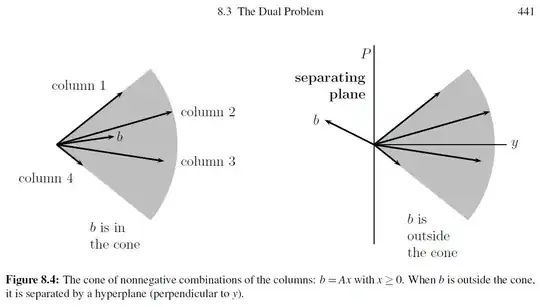There are several beautifully written posts on stackexchange about duality. For example:
- A technical explanation of duality that attempts to offer some intuitions including the insight that the primal and dual each sort of encode the other, so that you could reverse engineer one in order to reconstruct the other. In the same post, I found
- An interesting explanation of duality using epigraphs
This post on Quora was quite good. It maps $f(x)$ (to be minimized) as a function of $g(x)$ the constraint (i.e. a function of a function), something no one else does, and garners some interesting graphic insights with this trick.
This post on Science4All illustrates the ying and yang of feasible and dual feasible sets.
This Youtube video explains the role of the dual vector in the cross product.
But something is still not clicking for me!!
I want to understand what Gilbert Strang means when he says, explaining the Theorem of the Alternative in Chap. 8 of his book Linear Algebra and Its Applications, that:
- In $Ax = b$, the $b$ is in the column space of A, but
- Adding a contraint to the equation $Ax = b$ means that the "$b$'s will no longer fill out a subspace. Instead, they fill a cone-shaped region"
- If $b$ lies in this cone, there is a nonneative solution to $Ax = b$, otherwise not.
- If $b$ lies outside the cone, there will be a separating hyperplane perpendicular to y which has the vector $b$ on one side and the whole cone on the other side.
By Fundamental Theorem of LA we show $Ax = b$ has a solution by showing $b$ is in the $C(A)$. But the Theorem of the Alternative offers an alternative way to determine solvability: $Ax = b$ has a solution or there is a $y$ such that $yA =0$ and $yb \ne 0$ ... "In the language of subspaces, either $b$ is in the column space, or it has a component sticking into the left nullspace. That component is the required $y$."

Strang's comment continued: "Figure 8.4 shows a separating hyperplane which has the victor $b$ on one side and the whole cone on the other side. The plane consists of all vectors perpendicular to a fixed vector $y$. The angle between $y$ and $b$ is greater than 90 degrees, so $yb < 0$. The angle between $y$ and every column of $A$ is less than 90 degrees, so $yA \ge 0$. This is the alternative we are looking for. This theorem of the separating hyperplane is fundamental to mathematical economics"."
I realize I'm waving my hands big time here (or rather flailing like a beached dolphin), but I sense that Strang's diagram must be related somehow to this diagram Salman Khan offers of the respective roles of a matrix's row and null spaces in a solution to $Ax = b$.

I see a relationship here that torments me. Maybe it is not meaningful, but one thing that makes me suspect these two diagrams (Strang's and Khan's) might be related is that in the Simplex Method, the dual tableau is the transpose of the primal tableau, much as in any matrix A, the rows defining the row space are the transpose of the columns defining the column space. And, of course, the nullspace is also orthogonal to the row space.
Can someone help me tie these concepts together?